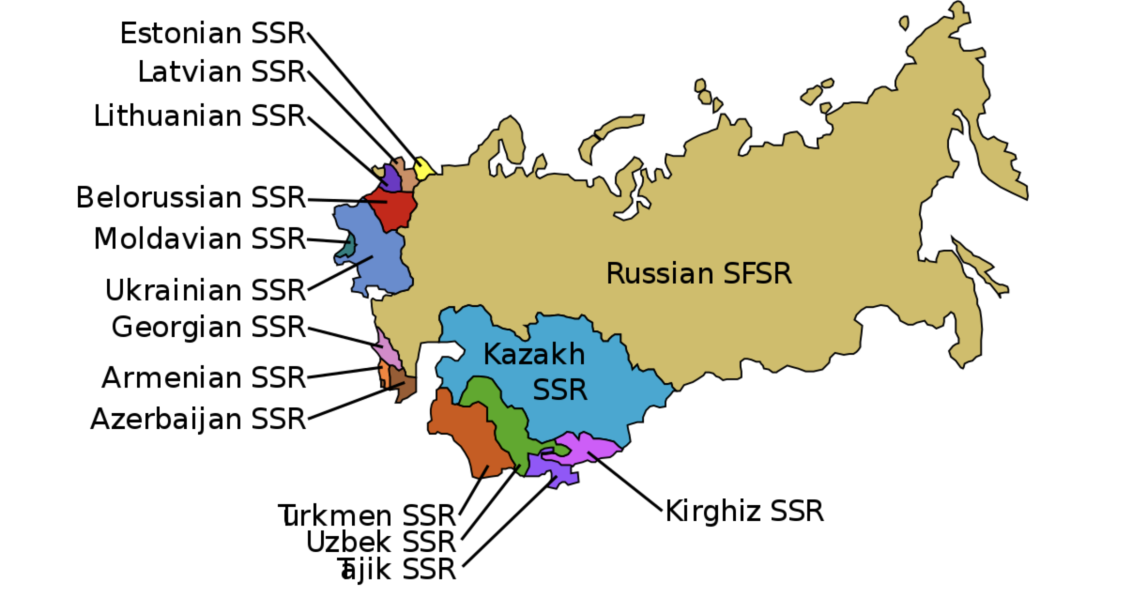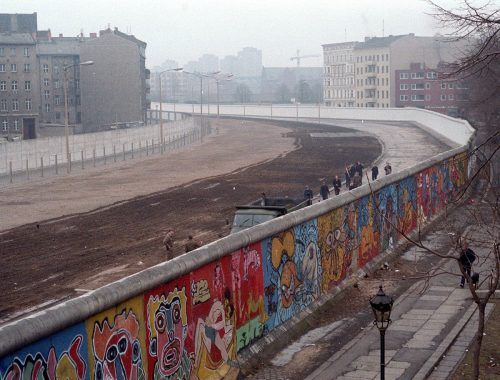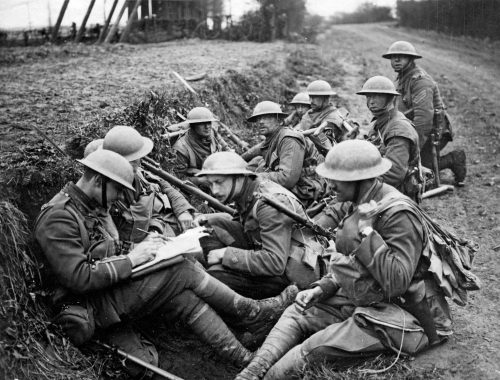
The Rise and Fall of the USSR
The Formation
By the end of 1917, Vladimir Lenin led the Russian also known as the October Revolution, which ended the monarchy of Czar Nicholas. Russia fought in the world war against Germany and the Ottoman Empire on its eastern and southeastern border. Due to its active engagement in the war, Russia became financially weak. It hurt the quality of life of the people and economy of Russia. In 1917, Vladimir Lenin led the October Revolution that ended the monarchy of Czar Nicholas. One of the main arguments of the revolutionaries against the emperor was that Russia did not need to engage in war and deteriorate itself. However, a civil war broke out in the region among many of the communist parties after Russia’s withdrawal from the war. But by 1922, Lenin found a way to unite everyone and formed the USSR.
The Union of Soviet Socialist Republics, popularly known as the USSR, was a group of 15 nation Soviets. A Soviet worked much like a parliament of current days, and each of them had its rules-regulations and laws. As all of these countries followed the socialist ideology, Lenin, with a vision to bring harmony among people and communities, created a democratic USSR. The 15 participating countries were Armenia, Azerbaijan, Belarus, Estonia, Georgia, Kazakhstan, Kyrgyzstan, Latvia, Lithuania, Moldova, Russia, Tajikistan, Turkmenistan, Ukraine, and Uzbekistan.
However, Lenin died in 1924, and Joseph Stalin took over the reign of the USSR. Stalin created a new Soviet in Moscow and called it the Supreme Soviet of the Soviet Union hence calling itself the most powerful among all the Soviets. It marked the beginning of the dictatorship in the USSR. He also created the one-party rule, which meant there could only be one communist party in the USSR. He put the control of the country on the ruling communist party (i.e. to himself), thus enabling him to take all the decisions and administer all the policies. Stalin also established the Politburo, a group of leaders responsible for choosing the leader of the USSR and taking all the decisions. In a way, Stalin and his Politburo had everything in control without any opposition.
As a dictator, Stalin controlled everything, and people who tried to protest were sent to prisons (Gulag) or killed. Some historians claim that Stalin was a worse dictator than Hitler because he killed more people than Hitler, which included his leaders, officers, and people of the country. After the death of Stalin in 1953, his successors continued to rule like him until Mikhail Gorbachov became the General Secretary of the USSR in 1985.
Beginning of the Downfall
Though the visible downfall of the USSR began after Mikhail Gorbachov came into power, there were other factors too. Here are some major reasons that led to the demise of the USSR.
- Dictatorship – From 1924 to 1985, the USSR had a dictator regime that created unrest in the country and among the people.
- Space Race – Though it seems unrelated, the space race between the USA and the USSR was one of the most important reasons behind the worsening economy of the USSR. In the end, the USSR won as it sent the first spaceship, man, and the dog into space, but it spent a lot of money and gained nothing substantial.
- Arms Race: USSR also spent a large chunk of its money to become atomic power rich. Naturally, it hurt the living condition of people and the economy of the country.
- Cold War: Between 1945 and 1991, the USSR was in Cold War with the USA. Being a communist nation, it wanted to spread communism in the world. It helped other communist countries like North Korea, China and Vietnam by supplying weapons, technology, money and raw materials. On the other side, the USA wanted a democratic world like theirs.
- Thwarted Economy: Unlike the USA, the people of the USSR were not allowed to establish or own a firm or factory. People worked in the factories and industries owned by the ruling Communist Party. The financial and living conditions of people could not improve in this arrangement. It was another big reason for a weaker economy, and the USSR kept falling behind the USA.
- Soviet-Afghan War: The communist government of Afghanistan was fighting against the rebellious group called Mujahideen. Mujahideen were agains the communist ideology. Since expansion of communism was one of the main goals of the USSR, they fought alongside the Afghan government. The war in the Afghanistan lasted for about ten years between 1979 and 1989. The USSR had to spend a lot of money to support this.
- Better Education: The number of educated people in the USSR kept on increasing despite all the restrictions placed by the ruling party. It made more people aware and put them against the dictatorship.
When Mikhail Gorbachov became the General Secretary of the Communist Party and the president of the USSR in 1985, he wanted to bring a change to improve the living condition of people, give them more freedom, and improve the economy of the country. Two of the policies to bring those reforms, he brought in were:
- Perestroika opened the door for elections and democracy, where people could vote to elect their leaders. It also brought foreign investment and private business in the USSR.
- Glasnost Policy was focussed on giving freedom to the people.
These two policies played a pivotal role in the fall of the USSR because it empowered the people and media, thus making it easier to spread the message against oppression of the ruling Communist Party. Many of the countries of the USSR, such as Turkmenistan, Kazakhstan, Estonia, Latvia, etc, started to rebel against the government in a hope of becoming an independent country.
Year of Revolution – 1989
The protest and revolution against communism was at its peak during this time. Countries like Poland, Bulgaria, and Romania rose against their communist governments. They were not part of the USSR but had puppet governments taking orders from Moscow Soviet. Then there were a few communist-governed countries like East Germany, Hungary, Czechoslovakia and Yugoslavia, where people started the revolution to break away from communism. As a result, by 1991, all these countries got rid of their communist government.
Before Mikhail Gorbachov came into power, the USSR always sent help to all the communist favouring countries in case of revolutions against the government. But he did not interfere with the internal matters of other countries.
Seeing the uprising of people breaking away from the communist government, Estonia, Latvia, and Lithuania, independent before the Second World War, demanded to be from the USSR. A series of calls to be free started after this among all other nations of the USSR.
The August Coup – 1991
Some of the leaders of the Politburo, including the vice president and defence minister, organised The August Coup of 1991. The idea was to overthrow Mikhail Gorbachov from the government as he was causing the USSR to fail. They put him under house arrest when Mikhail Gorbachov was on a trip to Crimea and spread the news in the USSR that he died in an attempt to impose an emergency that would have given all the powers to them. But under the leadership of Boris Yeltsin, another leader of the ruling communist party who was against the idea of the USSR and wanted to make Russia a free country, people came onto the roads in all the big cities like St. Petersburg and Moscow to demonstrate against this manoeuvre of the ruling party. The army was deployed in those cities to crush the rebels, but a few senior officers refused to follow the order, and they sided with the people.
Boris Yeltsin resigned from the communist party, the August Coup failed, and the people of Russia got their freedom from the USSR. An election was organised in which Boris Yeltsin won and became the first president of Russia.
Mikhail Gorbachov returned to Moscow, but the USSR had already started to disintegrate. Under Belovezha Accords on December 8th, 1991, Russia, Ukraine and Belarus agreed and became independent, and the USSR officially ceased to exist. Later on December 21st, 1991, Mikhail Gorbachov resigned. He was the eighth and last leader or the president of the USSR.
You May Also Like

The Rise & Fall of Berlin Wall
March 13, 2023
TL;DR of World War – I
March 20, 2023
